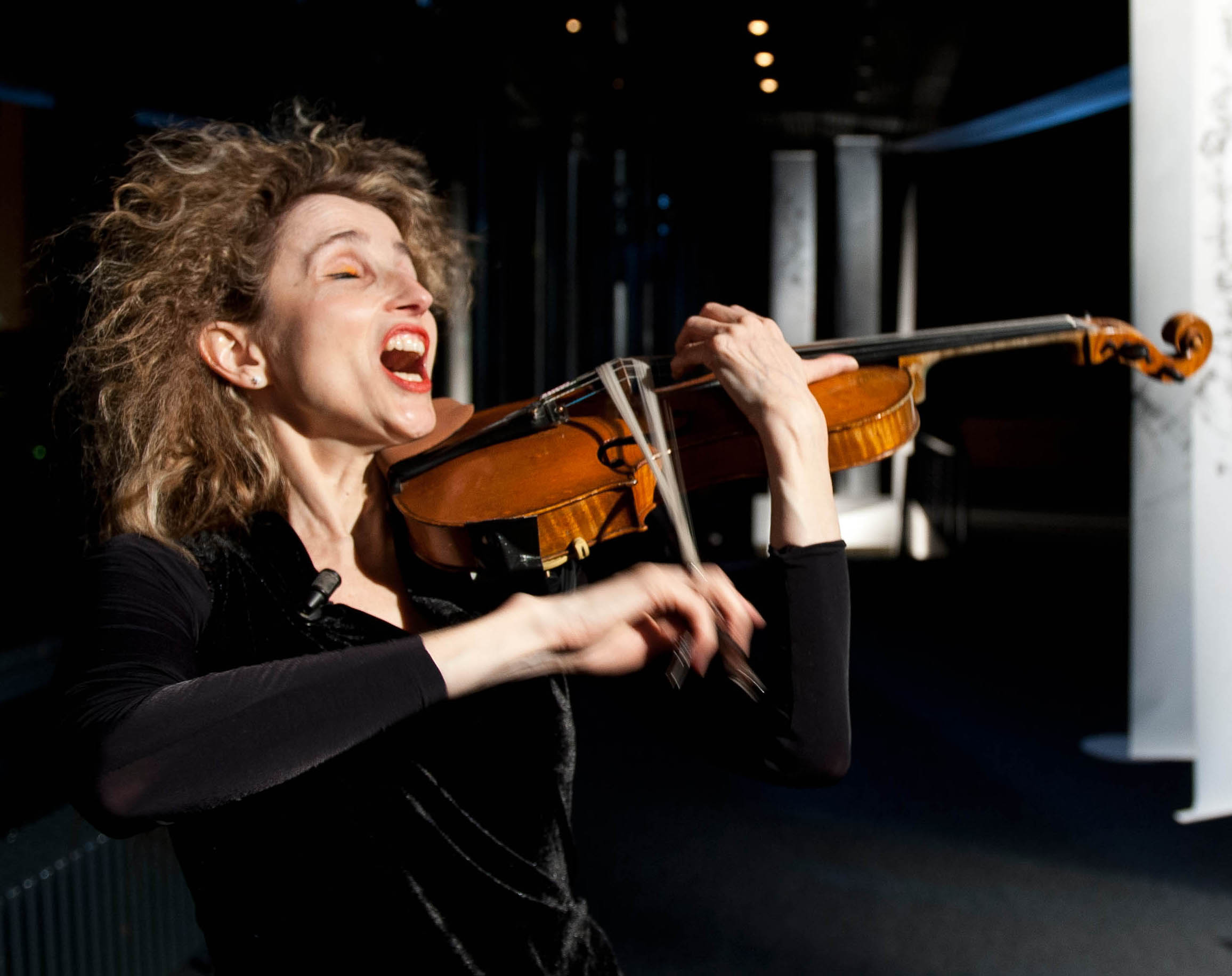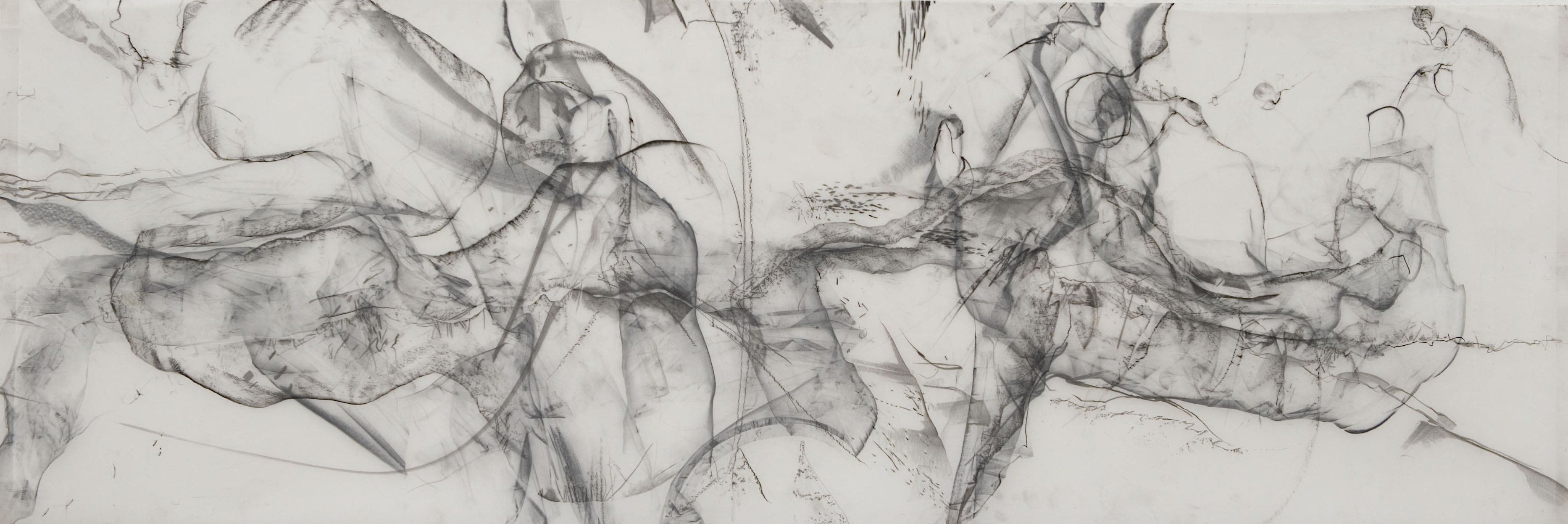Charlotte Hug im Gespräch zu vier neuen CDs

Gabrielle Weber
Charlotte Hug, Composer-Performerin, Bratschistin, Stimm– und Medien-Künstlerin, bewegt sich zwischen Komposition und Improvisation, zwischen Musik und Visueller Kunst. Vier neue CDs spiegeln ihre facettenreiche Künstlerpersönlichkeit. Im Gespräch beschreibt Hug diese als “Ernte” ihres Schaffens der letzten Jahre.
Charlotte, in deinen Performances weitest Du die Möglichkeiten deiner Haupt-Instrumente Viola und Stimme bis an deren Grenzen aus. Dazu kommt die starke Verbindung mit visuellen Aspekten. Wie sind die drei Elemente miteinander verknüpft?
Die Soloarbeit ist für mich ein wichtiger Ausgangspunkt, ich bin aber immer im Dialog. Die Stimme und die Viola kommunizieren miteinander. Sie sind sich auch oft nicht einig. Musik ist für mich immer ein mit Menschen in Kommunikation sein.
“Die Viola und ich: wir suchen jeden Tag erneut das Zwiegespräch.”
Den Bezug zum Visuellen schaffe ich durch die sogenannten Son–Icons, eine Verbindung, von Klang und Bild (oder Sons und Icons). Gehörte – reale oder imaginierte- Musik oder zufällige Umgebungsklänge zeichne ich mit beiden Händen auf. Wie ein Tanz mit mehreren Stiften auf halbtransparentem Papier. Daraus entstehen kleine Bildtafeln, meterlange Papierbahnen, Rauminstallationen, animierte Videopartituren. Mit Son-Icons habe ich eine Kompositionsmethode entwickelt.
“Das Auge entscheidet oft anders als das Ohr.”
Die Son–Icons sind Stimuli und Inspiration für Musik. Sie machen eine Entstehungsenergie sichtbar.
Portrait Charlotte Hug, Son-Icons ©Art-TV 2016, Michelle Ettlin
Die Improvisation bildet eine wichtige Basis deiner Arbeit. Was bedeutet für dich das Improvisieren?
Die Improvisation ist ein künstlerisches Lebenselixier, insbesondere die Magie der Begegnung im Musizieren mit Persönlichkeiten wie bspw. Lucas Niggli (CD Fulguratio). Improvisation bedeutet ein Kreieren im Moment. Beim Zusammenspiel mit dem Londoner Stellari String Quartet, das ich im Jahr 2000 gründete (vgl. CD Vulcan), entsteht bei jedem Auftritt eine Neukreation. Die Londoner Improvisationsszene hat mich seit fast zwanzig Jahren stark geprägt. Zunächst als festes Mitglied, jetzt als Gast und als Gastdirigentin, spielte ich regelmässig mit dem London Improvisers Orchestra (CD 20Jahr-Jubiläum).
Anhand der von Dir entwickelten Interaction-Notation erarbeitest Du intermediale Kompositionen mit Orchester und Chor. Wie sehen solche Zusammenarbeiten konkret aus?
Für jede/n Musiker/In zeichne ich ein individuelles Son-Icon. Es kann gedreht und gewendet, gespiegelt, als Krebs oder Umkehrung gelesen werden, in Analogie zu Kompositionsweisen von J. S. Bach oder der zweiten Wiener Schule. Dann halte ich individuelle Coachings ab. Jeder Musiker entwickelt aus seinem Son–Icon eigenes musikalisches Material.
“Interaction Notation ermöglicht die musikalische Begegnung auf Augenhöhe, das Einbringen verschiedener künstlerischen Ressourcen, das präzise Zusammenspiel ohne kulturelle Barrieren.”
Die Interaction Notation bildet eine Strukturierungsmethode. Ein Interface verbindet konventionelle westliche Notation, Son-Icons, graphische Notationen, Symbole für Bewegungen, oder lässt Liveeinspielungen abspielen. Musiker mit unterschiedlichem kulturellem oder interdisziplinärem Hintergrund interagieren dadurch spielend.

Wie arbeitest Du als Dirigentin in den intermedialen Settings mit grösseren Formationen?
Ich sehe mich als riesiges Ohr. Ich schaffe einen Raum, in dem Vertrauen und Akzeptanz herrschen, so dass etwas Mutiges stattfinden kann. Falls sich Routine einschleicht, stimuliere ich Wachheit durch Unerwartetes.
Auf der neuen Son–Icons-CD sind intermediale Kompositionen zu hören. Wie lässt sich die Verbindung zwischen Visuellem und Klang auf eine CD übertragen, ein Medium des reinen Klangs?
Eine szenische intermediale Performance ist ein Fest, ein immersives sinnliches Erlebnis zum Eintauchen. ein Aggregatszustand. Son-Icons funktionieren hingegen auch in Ausstellungen als Visual Music ohne Musik. Sie wecken innere Musik.
Charlotte Hug, Moscow Contemporary Music Ensemble, Lucas Niggli ©MAMM 2018
Umgekehrt ist auf Tonaufnahmen die Musik auch ohne visuellen Impuls gültig. Die Musik weckt innere Bilder. Der Vorteil des Mediums CD ist, das man sie mitnehmen, alleine hören, wieder hören, mehrmals eintauchen kann.
“Musik und Son–Icons funktionieren autonom – es sind verschiedene Aggregatszustände.”
Was sind kommende Projekte, hast du ein Wunschprojekt?
Einerseits forsche ich in der Soloarbeit am Zusammenhang mit Live-Elektronik, insbesondere an der Alchemie zwischen dem Analogen, dem Digitalen und dem Körper. Andererseits schwebt mir das Zusammenkommen von Son–Icons mit szenischen-intermedialen Elementen und bewegter musikalischer Dramaturgie vor – vielleicht eine Art von commedia dell’ ascolto intermediale interculturale…
Interview Gabrielle Weber
CDs:
–Fulguratio Duo Niggli-Hug, Label: Sluchaj
–Son-Icon Musik von Hug für Chor und Orchester (Lucerne Festival Academy Orchestra, via nova Chor München), Label: Sluchaj
-CD Vulcan, Stellari String Quartet, Wachsmann, Hug, Mattos, Edwards Label: Emanem
-Doppel-CD Twenty years on London Improvisers Orchestra
London Improvisers Orchestra, Via Nova Chor München
Sendungen SRF:
–Swisscorner, Musikmagazin, Annelis Berger zu CD Fulguratio, 27.4.19
–Die grosse Nachtmusik, Passage, 9.12.11
neo-profiles: Charlotte Hug, Lucas Niggli, Lucerne Festival Academy, Lucerne Festival

